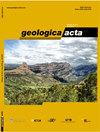含堇青石二长花岗岩(Sierra Bermeja Pluton,Iberian南部地块)中晚华力西期至后华力西时期的沃涅岩系岩石和钙碱性煌斑岩的岩石学和地球化学。
IF 2
4区 地球科学
Q2 GEOLOGY
引用次数: 8
摘要
Sierra Bermeja岩体(伊比利亚地块中伊比利亚带南部)是一个由含堇青石过铝二长花岗岩组成的晚瓦里西斯侵入岩。详细的野外测图揭示了几个NE-SW向纵向复合体的存在,这些复合体由隐晶质或显晶质中晶岩形成。根据岩石学和地球化学特征,将其划分为钙碱性煌斑岩系列和辉绿岩系列。其主要矿物学特征为不同数量的斜长石、角闪石、斜辉石、黑云母、钾长石、石英和磷灰石。总体上,它们的SiO2含量较低(49 ~ 56wt.%), MgO+FeOt (10 ~ 17wt.%)、K2O (3 ~ 5wt.%)、Ba (963 ~ 2095ppm)、Sr (401 ~ 1149ppm)和Cr (87 ~ 330ppm)含量较高。野外观测表明,辉长岩和煌斑岩构成两个独立的岩浆脉冲。辉长岩闪长岩是同深裂岩脉侵入的,而煌斑岩是在寄主二长花岗岩几乎完全固结后侵入的。这样,辉长岩系列岩石可以作为瓦里斯坎晚期地壳和地幔熔融过程同时发生的证据,而煌斑岩则代表这一阶段的结束。本文章由计算机程序翻译,如有差异,请以英文原文为准。
Petrography and geochemistry of late- to post-Variscan vaugnerite series rocks and calc-alkaline lamprophyres within a cordierite-bearing monzogranite (the Sierra Bermeja Pluton, southern Iberian Massif).
The Sierra Bermeja Pluton (southern Central Iberian Zone, Iberian Massif) is a late-Variscan intrusive constituted by cordierite-bearing peraluminous monzogranites. Detailed field mapping has allowed to disclose the presence of several NE–SW trending longitudinal composite bodies, formed by either aphanitic or phaneritic mesocratic rocks. According to their petrography and geochemistry these rocks are categorised as calc-alkaline lamprophyres and vaugnerite series rocks. Their primary mineralogy is characterised by variable amounts of plagioclase, amphibole, clinopyroxene, biotite, K-feldspar, quartz and apatite. Broadly, they show low SiO2 content (49–56wt.%), and high MgO+FeOt (10–17wt.%), K2O (3–5wt.%), Ba (963–2095ppm), Sr (401–1149ppm) and Cr (87–330ppm) contents. Field scale observations suggest that vaugneritic rocks and lamprophyres would constitute two independent magma pulses. Vaugneritic dioritoids intruded as syn-plutonic dykes, whereas lamprophyres were emplaced after the almost complete consolidation of the host monzogranites. In this way, vaugnerite series rocks would be an evidence for the contemporaneity of crustal- and mantle-melting processes during a late-Variscan stage, while lamprophyres would represent the ending of this stage.
求助全文
通过发布文献求助,成功后即可免费获取论文全文。
去求助
来源期刊

Geologica Acta
地学-地质学
CiteScore
2.50
自引率
6.70%
发文量
13
审稿时长
>12 weeks
期刊介绍:
- Relevant conceptual developments in any area of the Earth Sciences.
- Studies presenting regional synthesis.
- Thematic issues or monographic volumes presenting the results from one or more research groups.
- Short papers reflecting interesting results or works in progress.
- Contributions and results from Research Projects, Workshops, Symposiums, Congresses and any relevant scientific activity related to Earth Sciences.
- Geologica Acta aims to stimulate rapid diffusion of results and efficient exchange of ideas between the widespread communities of Earth Science researchers (with special emphasis on Latinamerica, the Caribbean, Europe, the Mediterranean
 求助内容:
求助内容: 应助结果提醒方式:
应助结果提醒方式:


